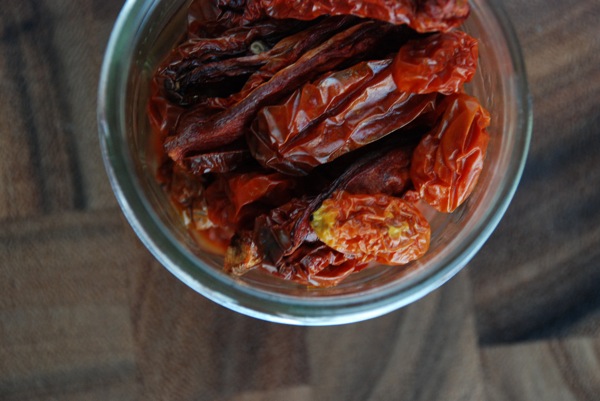Hi friends! Long time no see. I'm taking some time to let marriage soak in, and that means less time to blog. While I'm away, my friend Jeremy Brosowsky is sharing his method for preserving the last of summer's bounty. And DC folks -- Jeremy has a fantastic new company called Compost Cab, the perfect solution for us urban folk who want to compost but don't have a garden. Check it out.

Gather ye rosebuds, my friends. And by rosebuds, I mean tomatoes. We'll likely get another head-fake day or two, when the warm air makes it feel like summer even though the quality of the light is glaringly fall. But make no mistake: summer's over. Last-gasp time, folks.
For the next week, maybe two, you're going to see sad, lonely crates of tomatoes looking out of place among the hardened bounty of early fall at your local farmers' market. No, they're not as good as their mid-summer cousins, the ones so vibrant you want to bite into them like they're apples. These fall tomatoes need to be coaxed out. But, oh, is it worth it.
For much of the past couple of weeks, I've been plowing through 100 pounds of tomatoes -- that's two bushels, if you're keeping score at home. Most got sauced. But some 25 lucky pounds got oven-dried. It's the apotheosis of the fall tomato. And it couldn't be much easier.
The ingredient list is mercifully short. Tomatoes. Olive oil. Salt.
Tomatoes shrivel as they dry, so don't get caught up in looks -- seconds work just fine. You can use any kind of tomato you want -- it's a free country! But you're looking for sugar here, and plum tomatoes are the classic for a reason. When the February doldrums roll around and I'm aching for a taste of summer, I pop one of these suckers in my mouth, grin a stupid grin, and mumble something about how f**king happy I am that I made these oven-dried tomatoes way back before Halloween.
(I also make oven-dried grape tomatoes, which are awesome, too. Same process as below, but I leave them whole with a little burst of juice left inside.)
Most people use a baking sheet, but I've discovered that the tomatoes dry more quickly and uniformly when I cook them on a cooling rack. Another benefit of the rack is that you avoid any pooling of oil. I line a baking sheet with foil, place the rack on the sheet, and brush or spray the rack with oil.
I sort the plums by size to maximize the chance of each batch drying consistently. I wash and dry them. Then, working along the length of the tomato, I quarter the larger ones, and cut the smaller ones in half or thirds. Use your judgment. Place them on the rack as close together as possible without touching.
You're going to use precious little olive oil, just enough for an ultra-thin coating -- almost a sheen -- on the tomatoes. Because we use so little, and because the taste of the finished product is so straightforward and pure, I break out the good stuff from McEvoy Ranch (http://www.mcevoyranch.com/html/oil_vars.html). But whatever you have on hand will work fine. Use a brush.
I like kosher salt, but if all you have is table salt, that's cool. Either way, sprinkle evenly and judiciously.
Some people tell you to set your oven at the lowest possible setting, usually 170F or so. Others say you can go as high as 200F. I split the difference, set my oven to 185F, and don't worry about it. Put your tomatoes in the oven, and leave them be for six hours. At that point, start checking in on them. I aim for just on this side of leathery, which usually takes 10-12 hours. Remove them from the heat when they're what your looking for. And please, please, please don't forget about them -- it's just so sad when a batch morphs from candy-sweet to metallic-burnt because you fell asleep on the couch.
Once these little beauties cool, put them in a jar in the fridge and they'll keep for months. Little bites of summer. Love it. You will, too.
